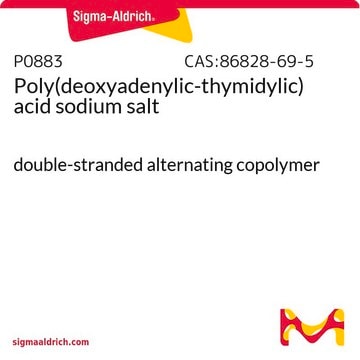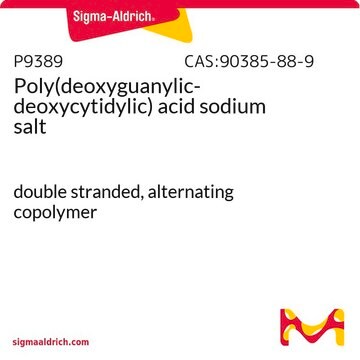P1038
Poly(cytidylic-inosinic) acid potassium salt
random copolymer
Synonym(s):
Poly (C,I)
Sign Into View Organizational & Contract Pricing
All Photos(2)
About This Item
Recommended Products
Application
Poly(cytidylic-inosinic) acid potassium salt has been used:
- in pretreatment to understand Con A-induced hepatitis in mice
- in RNA extraction from hemolymph plasma for qPCR detection assay
- to induce inflammatory changes in liver
- as a component of minimal essential medium for the stimulation of rainbow trout gonad line RTG-2 cells
Biochem/physiol Actions
Poly(cytidylic-inosinic) Poly(C,I) is a random copolymer of inosine and cytidine bases which may be useful for comparative physicochemical analysis versus other random copolymers such as Poly(C,A), Poly(C,U) and Poly(C,G).
Poly(cytidylic-inosinic) acid, poly I:C mimics viral RNA to induce immune response. Administration of poly I:C promotes cytotoxic functionality of natural killer cells and macrophages. However, poly I:C may trigger generation of anti-mitochondrial antibodies (AMAs) and contribute to the pathogenesis of primary biliary cirrhosis (PBC). Poly I:C may play a hepatoprotective role in Con A-induced T cell-dependent liver injury.
Other Notes
Random copolymer
Storage Class Code
11 - Combustible Solids
WGK
WGK 3
Flash Point(F)
Not applicable
Flash Point(C)
Not applicable
Personal Protective Equipment
dust mask type N95 (US), Eyeshields, Gloves
Certificates of Analysis (COA)
Search for Certificates of Analysis (COA) by entering the products Lot/Batch Number. Lot and Batch Numbers can be found on a product’s label following the words ‘Lot’ or ‘Batch’.
Already Own This Product?
Find documentation for the products that you have recently purchased in the Document Library.
Customers Also Viewed
Persistence of double-stranded RNA in insect hemolymph as a potential determiner of RNA interference success: evidence from Manduca sexta and Blattella germanica
Garbutt JS, et al.
Journal of Insect Physiology, 59(2), 171-178 (2013)
G F Joyce et al.
Journal of molecular biology, 188(3), 433-441 (1986-04-05)
Poly(C, G) random copolymer templates direct the oligomerization of 2-Me-ImpG and 2-MeImpC, resulting in the production of a variety of oligo(G, C)s. The efficiency of monomer incorporation into newly synthesized oligomers is greater for 2-MeImpG than for 2-MeImpC, and decreases
G F Joyce et al.
Journal of molecular biology, 176(2), 279-306 (1984-06-25)
Poly(C, U) random copolymer templates direct the oligomerization of 2-MeImpG and 2-MeImpA, resulting in the production of a variety of oligo/(G,A)s. The efficiency of monomer incorporation into newly synthesized oligomers is greater for 2-MeImpG than for 2-MeImpA, and decreases for
G F Joyce et al.
Journal of molecular biology, 202(3), 677-681 (1988-08-05)
Poly(C,A) random copolymer templates direct the oligomerization of 2-MeImpG (2-MeImpX is the 5'-phospho-2-methylimidazolide of the nucleoside X) and 2-MeImpU, resulting in the production of a variety of oligo (G,U)s. This reaction is less efficient than comparable reactions involving poly(C,U) or
The multi-hit hypothesis of primary biliary cirrhosis: polyinosinic-polycytidylic acid (poly I: C) and murine autoimmune cholangitis
Wang J, et al.
Journal of Hepatology, 44(3), 446-454 (2006)
Our team of scientists has experience in all areas of research including Life Science, Material Science, Chemical Synthesis, Chromatography, Analytical and many others.
Contact Technical Service












